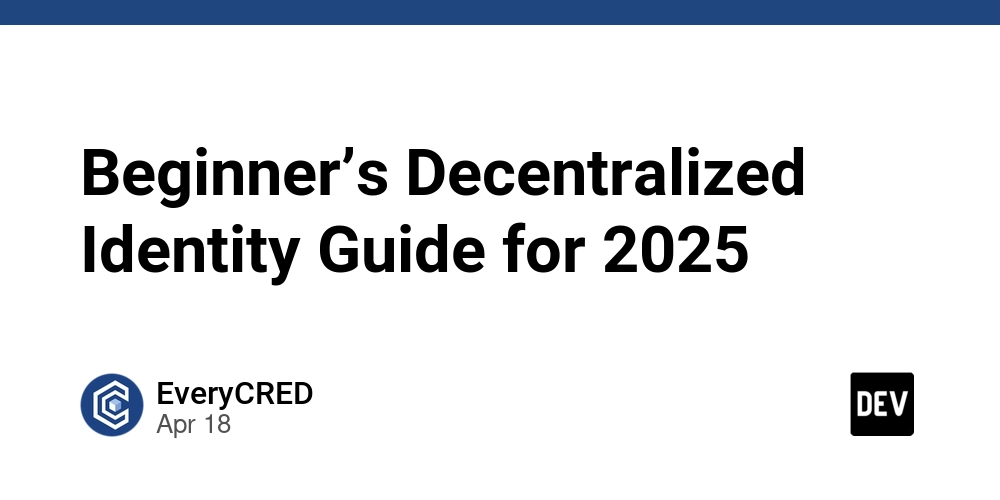Beginner’s Decentralized Identity Guide for 2025
What if you could control your digital identity without relying on big tech or government systems? That’s the promise of decentralized identity — a revolutionary approach that puts privacy, security, and ownership back in your hands. In this decentralized identity guide, we’ll walk you through everything you need to know in 2025 and beyond. From understanding how it works to exploring real-world use cases, this guide helps you navigate the shift from traditional, centralized systems to next-gen, self-sovereign identity solutions powered by blockchain. As the digital world grows more complex and cyber threats more frequent secure digital identity has never been more critical. Let’s explore how decentralized identity is becoming the foundation for a more trusted, user-controlled internet. What Is Decentralized Identity? In simple terms, decentralized identity is a modern approach to managing your digital identity — one where you own and control your data, not a central authority. Traditionally, our personal information is stored and verified by third parties — like banks, social media platforms, or government databases. These centralized identity systems create single points of failure, raise privacy concerns, and put users at risk of data breaches. A decentralized identity system flips that model. Instead of relying on one central organization, it uses blockchain technology or distributed ledgers to let individuals manage their identity securely and independently. This decentralized identity guide helps you understand how this next-gen model works, and why it's critical in the future of online identity. How Does Decentralized Identity Work? Decentralized identity operates on a set of core technologies that provide the foundation for user-controlled identity systems. Understanding these technologies will help you grasp how a decentralized identity system can replace traditional models that rely on centralized authorities. At its heart, decentralized identity leverages blockchain or distributed ledgers to establish trust between parties without needing a middleman. This decentralization ensures that users own their data and can share it securely, only when necessary. Core Technologies Behind Decentralized Identity Blockchain Technology Blockchain serves as the backbone of decentralized identity systems. By utilizing a public, immutable ledger, blockchain ensures that identity data remains secure, transparent, and tamper-proof. This system allows users to self-verify their credentials without relying on third parties, making it the perfect solution for the future of digital identity. Distributed Ledgers Distributed ledgers are similar to blockchains but can be more flexible in terms of privacy and scalability. They maintain decentralized control and ensure that identity information is not stored on a single server, reducing risks associated with data breaches. Cryptographic Techniques Cryptography ensures the security of decentralized identity systems. Through digital signatures and encryption, users can prove their identity while keeping sensitive data hidden. This is what enables secure digital identity verification in a world where privacy and security are top priorities. The Role of DIDs (Decentralized Identifiers) Decentralized Identifiers (DIDs) are a fundamental building block of decentralized identity systems. DIDs are unique identifiers that are fully under the control of the user, not tied to a central authority. Key Features of DIDs: User Control: The individual controls the creation, management, and revocation of their DID. Interoperability: DIDs work across multiple platforms, allowing for universal compatibility. Self-sovereignty: DIDs enable users to prove their identity independently, without relying on a third-party issuer. In short, DIDs enable a self-sovereign identity where the individual is the sole manager of their personal data and credentials. Verifiable Credentials Explained Verifiable credentials (VCs) are digital proofs of identity issued by trusted entities. These credentials can be anything from a driver's license, diploma, or professional certification. In a decentralized identity system, users receive verifiable credentials and can choose when to share them with others. These credentials are cryptographically signed by the issuer and can be independently verified, ensuring their authenticity. For example, a verifiable credential might be a certificate that proves you’ve completed a course, issued by an accredited institution. When shared, others can verify the credential without needing to directly contact the institution. Pro Tip: Verifiable credentials allow for easy identity verification blockchain interactions — helping avoid the need for a central database. Benefits of Decentralized Identity As the digital landscape evolves, the need for secure and user-fr

What if you could control your digital identity without relying on big tech or government systems?
That’s the promise of decentralized identity — a revolutionary approach that puts privacy, security, and ownership back in your hands.
In this decentralized identity guide, we’ll walk you through everything you need to know in 2025 and beyond. From understanding how it works to exploring real-world use cases, this guide helps you navigate the shift from traditional, centralized systems to next-gen, self-sovereign identity solutions powered by blockchain.
As the digital world grows more complex and cyber threats more frequent secure digital identity has never been more critical. Let’s explore how decentralized identity is becoming the foundation for a more trusted, user-controlled internet.
What Is Decentralized Identity?
In simple terms, decentralized identity is a modern approach to managing your digital identity — one where you own and control your data, not a central authority.
Traditionally, our personal information is stored and verified by third parties — like banks, social media platforms, or government databases. These centralized identity systems create single points of failure, raise privacy concerns, and put users at risk of data breaches.
A decentralized identity system flips that model. Instead of relying on one central organization, it uses blockchain technology or distributed ledgers to let individuals manage their identity securely and independently.
This decentralized identity guide helps you understand how this next-gen model works, and why it's critical in the future of online identity.
How Does Decentralized Identity Work?
Decentralized identity operates on a set of core technologies that provide the foundation for user-controlled identity systems. Understanding these technologies will help you grasp how a decentralized identity system can replace traditional models that rely on centralized authorities.
At its heart, decentralized identity leverages blockchain or distributed ledgers to establish trust between parties without needing a middleman. This decentralization ensures that users own their data and can share it securely, only when necessary.
Core Technologies Behind Decentralized Identity
-
Blockchain Technology
Blockchain serves as the backbone of decentralized identity systems. By utilizing a public, immutable ledger, blockchain ensures that identity data remains secure, transparent, and tamper-proof. This system allows users to self-verify their credentials without relying on third parties, making it the perfect solution for the future of digital identity.
-
Distributed Ledgers
Distributed ledgers are similar to blockchains but can be more flexible in terms of privacy and scalability. They maintain decentralized control and ensure that identity information is not stored on a single server, reducing risks associated with data breaches.
-
Cryptographic Techniques
Cryptography ensures the security of decentralized identity systems. Through digital signatures and encryption, users can prove their identity while keeping sensitive data hidden. This is what enables secure digital identity verification in a world where privacy and security are top priorities.
The Role of DIDs (Decentralized Identifiers)
Decentralized Identifiers (DIDs) are a fundamental building block of decentralized identity systems. DIDs are unique identifiers that are fully under the control of the user, not tied to a central authority.
Key Features of DIDs:
- User Control: The individual controls the creation, management, and revocation of their DID.
- Interoperability: DIDs work across multiple platforms, allowing for universal compatibility.
- Self-sovereignty: DIDs enable users to prove their identity independently, without relying on a third-party issuer.
In short, DIDs enable a self-sovereign identity where the individual is the sole manager of their personal data and credentials.
Verifiable Credentials Explained
Verifiable credentials (VCs) are digital proofs of identity issued by trusted entities. These credentials can be anything from a driver's license, diploma, or professional certification.
In a decentralized identity system, users receive verifiable credentials and can choose when to share them with others. These credentials are cryptographically signed by the issuer and can be independently verified, ensuring their authenticity.
For example, a verifiable credential might be a certificate that proves you’ve completed a course, issued by an accredited institution. When shared, others can verify the credential without needing to directly contact the institution.
Pro Tip: Verifiable credentials allow for easy identity verification blockchain interactions — helping avoid the need for a central database.
Benefits of Decentralized Identity
As the digital landscape evolves, the need for secure and user-friendly identity solutions grows. Decentralized identity offers a range of benefits that address the weaknesses of traditional identity systems. By putting users in control, decentralized systems bring privacy, security, and seamless verification to the forefront of the digital experience.
1. User Privacy and Control
One of the primary benefits of decentralized identity is the enhanced privacy and control it gives users over their personal data. In a decentralized system, you are the sole owner of your identity, and you control who can access your information.
- Selective Sharing: With decentralized identifiers (DIDs), users can choose to share only specific pieces of their identity, ensuring that sensitive information remains private.
- No Centralized Data Storage: Unlike traditional models, which store personal data in centralized databases, decentralized systems keep your information secure and distributed across multiple nodes, significantly reducing the risk of large-scale data breaches.
- Transparency: Every transaction involving your identity is logged on a blockchain, allowing users to track and verify the data shared at any given time.
This shift in identity management puts privacy back in the hands of the individual, paving the way for more privacy-focused identity solutions.
2. Security and Fraud Reduction
Security is a major concern in today's digital world, especially when it comes to identity verification. Traditional systems are vulnerable to breaches, hacks, and identity theft due to their centralized nature. Decentralized identity systems drastically reduce these risks by leveraging blockchain technology.
- Tamper-proof Data: Once data is recorded on the blockchain, it cannot be changed or deleted. This makes it virtually impossible for hackers to alter your identity information.
- Multi-Factor Authentication: Many decentralized systems integrate decentralized authentication techniques, offering multiple layers of security — from biometrics to cryptographic keys.
- Fraud Prevention: With a decentralized identity, users can prevent impersonation and fraud since credentials are verifiable through trusted, cryptographically secure methods.
As a result, decentralized identity systems provide a much stronger defense against online threats, reducing the chances of fraud and identity theft.
3. Seamless Verification Across Platforms
The convenience of seamless verification is a game-changer in the digital identity world. Decentralized identity systems allow users to authenticate themselves quickly and securely across various platforms — without needing to create new accounts or re-enter personal details each time.
- Cross-Platform Usability: With verifiable credentials, users can prove their identity across multiple platforms, whether for signing up for new services, logging into accounts, or even verifying professional qualifications.
- No Passwords Required: Since users can authenticate with their blockchain-based identity, passwords may soon become a thing of the past. This not only improves security but also simplifies the verification process.
- Efficiency: With self-sovereign identity, there’s no need to depend on third-party verification each time you interact online, streamlining transactions and saving time.
This ability to quickly and securely verify identities across platforms is particularly crucial in the fast-paced world of digital identity trends 2025, where users demand convenience and security in equal measure.
Key Technologies Powering Identity Decentralization
The evolution of decentralized identity is fueled by cutting-edge technologies that enable secure, scalable, and trustworthy systems. These technologies make it possible for users to maintain control over their personal data while interacting with various digital platforms. Here, we’ll explore three key technologies that are shaping the future of decentralized identity systems.
1. Blockchain: The Foundation of Decentralized Identity
At the core of decentralized identity lies blockchain technology. Blockchain provides the infrastructure for secure digital identity systems by offering an immutable, distributed ledger that stores identity-related information without a central authority.
- Tamper-Proof Records: Blockchain ensures that once identity data is recorded, it cannot be altered or deleted, providing a secure and transparent way to manage identity credentials.
- Decentralization: By removing central control, blockchain enables trust between users and services without relying on intermediaries, making it a perfect fit for self-sovereign identity solutions.
- Scalability: Blockchain allows identity data to be managed and updated across multiple platforms without bottlenecks or performance degradation, enabling the seamless verification of identity across the digital world.
This decentralized ledger plays a crucial role in ensuring that individuals remain the sole custodians of their personal information, a cornerstone of the future-proof identity solutions.
2. Cryptography and Zero-Knowledge Proofs (ZKPs)
Cryptography is essential for safeguarding identity data in decentralized systems, ensuring that user information is securely shared and verified. Zero-knowledge proofs (ZKPs) are a breakthrough cryptographic technique that adds an extra layer of privacy to decentralized identity systems.
- Encryption: Encryption ensures that sensitive identity data (e.g., birth date, address) remains private, even when shared for verification. Only the necessary data is disclosed.
- Zero-Knowledge Proofs (ZKPs): ZKPs allow users to prove their identity or the validity of a credential without revealing the underlying data. For example, you can prove you're over 18 without disclosing your exact birthdate.
- Privacy and Security: ZKPs are crucial for implementing privacy-focused identity solutions, enabling individuals to verify their identity or attributes in a manner that protects their sensitive information from exposure.
This combination of cryptography and ZKPs strengthens the privacy and security of decentralized identity systems, making them reliable for both users and service providers.
3. Interoperability Protocols (e.g., DIDComm, W3C Standards)
For decentralized identity systems to be effective, they need to work seamlessly across various platforms and services. Interoperability protocols enable this by defining common standards that ensure smooth communication between different systems.
- DIDComm (Decentralized Identifier Communication): DIDComm is a protocol designed to enable secure messaging and interactions between decentralized identities. It ensures that decentralized identifiers (DIDs) can be used to securely communicate across multiple platforms and services.
- W3C Standards: The W3C DID Specification and Verifiable Credentials standards are widely adopted protocols for creating interoperable decentralized identity solutions. These standards allow systems to exchange verifiable credentials, such as professional certifications or diplomas, with a universal framework.
- Cross-Platform Compatibility: With these interoperability protocols, users can manage their self-sovereign identity across various digital ecosystems, from social media platforms to online marketplaces.
These protocols ensure that decentralized identity systems are not siloed, enabling seamless verification across platforms and establishing a truly global identity infrastructure.
Real-World Use Cases & Applications
The potential for decentralized identity is vast, extending beyond theoretical concepts to real-world applications that are already transforming industries. From financial services to healthcare and education, decentralized identity is reshaping how we manage and verify personal data. Here, we explore some of the most impactful use cases.
1. Financial Services: KYC and Onboarding
In the financial services industry, Know Your Customer (KYC) regulations and client onboarding processes are critical to ensuring compliance, security, and trust. However, traditional methods of verification are often slow and cumbersome, relying on centralized authorities and paper-based documentation. Decentralized identity offers a more efficient, secure, and user-friendly solution.
- KYC Simplification: With decentralized identifiers (DIDs) and verifiable credentials, customers can prove their identity once and use that data for multiple service providers, significantly reducing friction in onboarding.
- Improved Fraud Prevention: Blockchain's immutable ledger ensures that once identity data is recorded, it cannot be tampered with, reducing the risk of fraudulent identity claims.
- Faster Onboarding: The ability to share verified identity credentials instantly across platforms enables financial institutions to onboard customers more efficiently, cutting down wait times and improving the user experience.
For the future of digital identity, this streamlined process will enhance security, improve regulatory compliance, and create a more seamless experience for customers.
2. Healthcare: Medical Records and Access Control
The healthcare industry is another sector where decentralized identity can have a profound impact. Patient data is highly sensitive, and ensuring its privacy and security is paramount. Decentralized identity can help manage medical records and access control securely and efficiently.
- Secure Patient Records: By using verifiable credentials, patients can control access to their medical records and share them only with authorized healthcare providers. This eliminates the need for a centralized health information system, reducing the risk of data breaches.
- Access Control: Medical professionals can authenticate their identities using DIDs to access patient records, ensuring that only authorized individuals can view sensitive information.
- Patient Consent: Patients have full control over who can access their health data, improving privacy and ensuring compliance with regulations like HIPAA.
As the healthcare industry looks to implement more secure digital identity solutions, decentralized systems can make a significant contribution by offering privacy-focused identity solutions and reducing risks associated with centralized data storage.
3. Education: Digital Diplomas and Credentials
In the education sector, decentralized identity is helping to verify and authenticate academic credentials in a more secure, efficient, and tamper-proof manner. The traditional process of verifying diplomas and degrees is slow and susceptible to fraud. With blockchain-based identity systems, institutions can issue digital diplomas and certificates that are instantly verifiable and immutable.
- Digital Diplomas and Certificates: Students can receive their verifiable credentials directly from institutions, ensuring that their academic records are both accurate and accessible. These credentials can then be shared with potential employers or other educational institutions.
- Fraud Prevention: Since credentials are stored on an immutable blockchain, they cannot be altered or falsified, making it easier to verify license and educational qualifications.
- Global Recognition: These digital certificates can be recognized and verified globally, eliminating the need for paper documentation and speeding up the credential verification process.
This application is transforming credentialing services in education by providing a next-gen digital identity solution that is more secure, efficient, and trustworthy.
4. Government & Digital ID Programs
Governments around the world are exploring the use of decentralized identity to replace traditional forms of identification with digital ID programs. These programs can streamline services, improve accessibility, and ensure security and privacy for citizens.
- National Digital IDs: Countries like Estonia and Canada have already implemented digital ID programs, enabling citizens to use a single, secure digital identity for accessing government services, voting, and more.
- Secure Voting: By using blockchain-based identity systems, governments can allow citizens to authenticate themselves for online voting, ensuring that only authorized individuals can participate in elections.
- Public Service Access: Citizens can access social security benefits, healthcare services, and more, all through their decentralized digital identities, reducing the need for physical documents and improving efficiency.
This trend will continue to grow as governments seek to implement digital identity management systems that are secure, scalable, and more efficient.
Challenges and Barriers to Adoption
While decentralized identity holds immense promise for transforming how we manage personal data, its widespread adoption faces several challenges. These barriers range from technical complexity to regulatory hurdles and resistance from legacy identity providers. In this section, we’ll explore the key obstacles hindering the mainstream use of decentralized identity systems.
1. Technical Complexity
One of the most significant challenges to the adoption of decentralized identity is the technical complexity involved in building and maintaining the infrastructure.
- Blockchain Infrastructure: The underlying blockchain technology can be complex and resource-intensive, requiring significant expertise to develop and scale decentralized systems. While blockchain offers security and decentralization, it can also introduce scalability issues and high transaction costs, especially with public blockchains.
- Interoperability Issues: Ensuring that decentralized identifiers (DIDs) and verifiable credentials can communicate seamlessly across different platforms is a difficult technical hurdle. Lack of standardization or inconsistency in how these technologies are implemented can result in compatibility issues.
- Integration with Existing Systems: Integrating decentralized identity solutions with legacy identity management systems can be a major challenge. Many businesses and governments are still reliant on traditional identity models, making the transition to a decentralized framework a complex process.
These technical barriers make it difficult for many organizations to adopt decentralized systems, especially when considering the expertise and investment needed to overcome these issues.
2. User Experience and Education
Another significant hurdle is the user experience and the need for widespread education around decentralized identity solutions.
- User Adoption: For decentralized identity systems to work effectively, users must be willing to adopt and use these solutions. Many people are still unfamiliar with concepts like self-sovereign identity or blockchain-based identity systems, which can create resistance to adoption.
- Complexity for Non-Technical Users: The process of managing digital identities using technologies like DIDs and cryptographic keys can be overwhelming for non-technical users. The lack of user-friendly interfaces and tools may discourage adoption.
- Education and Awareness: There is a significant need for educational efforts to help users understand the benefits of decentralized identity systems, especially in terms of privacy, security, and control over their personal data. Many people are unaware of how these systems can improve their digital lives.
For decentralized identity to become mainstream, it’s crucial to design systems that are intuitive and easy to use, and to invest in educating users about the benefits and potential of these solutions.
3. Regulatory Hurdles
The legal and regulatory landscape is another major challenge for decentralized identity adoption. Governments and regulatory bodies have yet to create comprehensive frameworks that support decentralized systems, which creates uncertainty for businesses and users alike.
- Data Privacy Regulations: Countries and regions have varying laws regarding data privacy (e.g., GDPR in Europe). These regulations often rely on centralized systems for data storage and management, which creates tension with the decentralized nature of blockchain-based identity solutions.
- Compliance Issues: Organizations seeking to adopt decentralized identity must ensure their solutions comply with local and international laws, which may be difficult if regulatory guidelines are not clear or standardized.
- Lack of Global Consensus: While some countries, such as Estonia, have pioneered digital identity programs, there is no global consensus on the standards and regulations that should govern decentralized identity systems. This lack of standardization can slow adoption and lead to fragmented solutions.
Addressing regulatory hurdles is critical to making decentralized identity viable on a global scale. Without a clear regulatory framework, businesses and governments may hesitate to implement these solutions.
4. Resistance from Legacy Identity Providers
Many legacy identity providers, such as banks, government agencies, and traditional identity management companies, are deeply invested in the status quo and may be resistant to adopting decentralized systems.
- Established Business Models: Legacy providers often rely on centralized databases and traditional methods of identity verification, which have been effective for decades. Switching to a decentralized identity model requires a significant investment in new technologies, training, and processes.
- Control Over Data: Decentralized identity shifts control away from these traditional providers to the individual. This loss of control can be a major obstacle for organizations that rely on centralized control over identity data for revenue generation and risk management.
- Concerns About Security: While decentralized identity offers increased security in many cases, some legacy providers may be skeptical about the new technology and the potential risks associated with it, such as vulnerabilities in blockchain protocols or key management.
Overcoming resistance from these traditional players is essential for decentralized identity to gain widespread adoption. The transition requires cooperation from legacy systems and a shift in how identity management is perceived and handled.
The Future of Digital Identity
As we move further into the digital age, the landscape of digital identity continues to evolve. Decentralized identity is poised to play a central role in shaping the future of how we authenticate ourselves online. In this section, we’ll explore the trends driving this transformation, the importance of interoperability, and how organizations can future-proof their identity strategies to stay ahead in 2025 and beyond.
1. Trends Shaping Identity in 2025 and Beyond
The future of digital identity is defined by several emerging trends that promise to revolutionize how we manage and verify identities.
- Rise of Self-Sovereign Identity (SSI): Self-sovereign identity is at the core of decentralized identity systems, allowing individuals to own and control their data. In the coming years, SSI will gain greater adoption, giving users complete control over their digital identity and the ability to share data only when necessary.
- Blockchain-Based Identity Solutions: Blockchain technology will continue to serve as the foundation for digital identity management, offering increased security, privacy, and transparency. Expect more organizations to integrate blockchain-based identity systems into their operations to safeguard against fraud and ensure data integrity.
- AI and Machine Learning Integration: AI and ML will enhance digital identity solutions by enabling better fraud detection, predictive analytics, and identity verification processes. This will streamline identity management and make it more efficient and secure.
- Privacy and Security Innovation: As concerns over data breaches and identity theft grow, privacy-centric features like zero-knowledge proofs will become more widely adopted in decentralized identity solutions, ensuring that users’ personal information remains protected.
- Digital Identity as a Service (DIaaS): The rise of Digital Identity as a Service platforms will make it easier for organizations to integrate decentralized identity solutions into their systems without needing to build them from scratch. These platforms will offer customizable identity solutions for various sectors, such as finance, healthcare, and government.
By understanding and adapting to these emerging trends, businesses can stay ahead of the curve and implement more robust and secure digital identity solutions.
2. Importance of Interoperability
For decentralized identity to reach its full potential, interoperability between different systems and platforms is crucial. Without it, the ability to use a digital identity across various services, sectors, and geographical locations would be limited.
- Cross-Platform Compatibility: Interoperability protocols such as DIDComm and W3C standards are being developed to ensure that decentralized identifiers (DIDs) and verifiable credentials can be seamlessly shared and verified across different platforms, regardless of the underlying technology.
- Universal Access to Digital Identity: With proper interoperability, users can control their digital identity on one platform and use it across multiple services, including social networks, healthcare systems, financial institutions, and government services. This would significantly enhance user experience and adoption.
- Global Standards: To drive global adoption, it’s essential to establish universal standards for decentralized identity. These standards will facilitate the smooth exchange of verifiable credentials and help avoid fragmentation in the global digital identity ecosystem.
The more interoperable the systems are, the easier it will be for users and businesses to adopt and scale decentralized identity solutions, creating a unified and efficient digital identity infrastructure.
3. Future-Proofing Your Identity Strategy
As decentralized identity becomes more mainstream, businesses and organizations must take steps to future-proof their identity strategies. This ensures that their systems are not only ready for the changes of 2025 but can also adapt to the evolving landscape of digital identity.
- Embrace Flexibility and Scalability: To stay ahead of the competition, businesses should implement flexible, scalable digital identity solutions that can grow with technological advancements and accommodate future shifts in regulatory requirements.
- Stay Updated with Regulatory Changes: As governments worldwide continue to shape the legal framework for decentralized identity, it’s essential for organizations to stay informed about regulatory developments, such as GDPR or new digital ID programs, to ensure compliance.
- Invest in User-Centric Design: The future of digital identity will heavily depend on how easy it is for users to adopt and manage their digital identities. Companies should invest in user experience (UX) to ensure that systems are intuitive and simple, even for non-technical users.
- Focus on Security and Privacy: With the increasing emphasis on data protection, businesses must ensure that their digital identity solutions are equipped with the latest privacy and security features, such as zero-knowledge proofs and end-to-end encryption, to safeguard users’ personal information.
- Collaborate on Interoperability: Organizations must participate in global efforts to establish interoperability protocols, helping create a cohesive ecosystem where decentralized identity can flourish across borders and industries.
By considering these factors, businesses can ensure their identity management strategies are well-equipped to handle the challenges and opportunities of decentralized identity in the coming years.
How to Get Started with Decentralized Identity
Adopting decentralized identity can seem like a daunting task, but it’s becoming increasingly essential for individuals, developers, and businesses to understand and integrate these technologies. In this section, we will outline clear steps to help you get started with decentralized identity, explore the tools and platforms that can help, and provide an evaluation checklist to ensure your system is secure, compliant, and scalable.
1. Steps for Individuals
For individuals looking to embrace decentralized identity, the process begins with understanding the basic concepts and taking the first steps toward managing your own digital identity.
- Step 1: Learn About Decentralized Identity: Start by familiarizing yourself with the key principles of self-sovereign identity (SSI), DIDs, and verifiable credentials. Resources like online articles, webinars, and educational platforms can help build your foundational knowledge.
- Step 2: Choose a Digital Identity Wallet: A digital identity wallet allows you to manage your decentralized identifiers (DIDs) and verifiable credentials securely. Popular wallets like uPort and Microsoft Entra enable users to create and manage their digital identities.
- Step 3: Verify Your Identity: You can start by getting verified through supported platforms that use decentralized identity systems. For instance, you might verify your credentials with organizations that issue verifiable credentials, such as educational institutions or employers.
- Step 4: Control Your Data: As you start using decentralized identity solutions, remember that you hold control over your digital identity. Choose to share or revoke access to your data at any time, ensuring your privacy and security.
This process will help individuals take full ownership of their digital identity and ensure privacy and control.
2. Steps for Developers
For developers, building decentralized identity systems requires understanding the technology and integrating it into your applications or services.
- Step 1: Learn the Basics of DIDs and Verifiable Credentials: Understand the core technologies behind decentralized identity, including blockchain-based identity solutions and cryptographic methods. Familiarize yourself with W3C DID and verifiable credential standards.
- Step 2: Select a Platform or Framework: Choose a framework or platform that supports the integration of DIDs and verifiable credentials into your applications. Tools like uPort and EveryCRED provide the infrastructure needed to create decentralized identity solutions.
- Step 3: Develop and Test Your Identity Solutions: Using the chosen platform, begin developing features like decentralized authentication, identity verification, and secure access. Ensure the system is secure by implementing encryption and privacy measures.
- Step 4: Ensure Interoperability: Ensure that your solution adheres to key interoperability protocols (e.g., DIDComm, W3C standards) to enable seamless integration with other platforms and services.
- Step 5: Integrate with Existing Systems: Integrate decentralized identity solutions into your existing applications, whether they are for healthcare, finance, or education, making sure that they work well with legacy systems while offering new benefits.
By following these steps, developers can create secure, interoperable digital identity systems that empower users with full control over their personal information.
3. Steps for Businesses
For businesses, adopting decentralized identity solutions can significantly enhance security, privacy, and operational efficiency. Here’s how businesses can get started.
- Step 1: Understand the Business Use Cases: Identify how decentralized identity can benefit your business. Use cases might include KYC (Know Your Customer) processes, secure onboarding, or protecting sensitive employee data.
- Step 2: Evaluate Platforms and Providers: Choose the right decentralized identity platform based on your business needs. Platforms like EveryCRED provide customizable solutions for large-scale identity verification and credential management.
- Step 3: Implement Identity Management Solutions: Start by integrating decentralized identity solutions for managing digital credentials for your employees, customers, or partners. For example, implementing verifiable credentials for onboarding and certification purposes can reduce fraud and enhance trust.
- Step 4: Ensure Regulatory Compliance: Make sure that your solution complies with relevant data protection regulations (e.g., GDPR). Many platforms, such as Microsoft Entra, provide compliance features to help businesses stay on the right side of privacy laws.
- Step 5: Scale the Solution: As your business grows, ensure that your decentralized identity system can scale. Focus on systems that offer flexibility, scalability, and interoperability with other platforms, ensuring long-term usability.
By following these steps, businesses can integrate decentralized identity solutions into their operations, improving trust and security for both employees and customers.
4. Evaluation Checklist: Privacy, Compliance, Scalability
Before adopting a decentralized identity solution, it’s essential to evaluate the platform or technology against key criteria to ensure it meets your needs.
- Privacy: Ensure that the platform provides strong privacy protections, such as zero-knowledge proofs, end-to-end encryption, and user consent management to protect sensitive personal data.
- Compliance: Check if the solution complies with relevant regulations such as GDPR (General Data Protection Regulation) or eIDAS for businesses operating in Europe. Compliance ensures that you can legally store and manage digital identity data.
- Scalability: Verify whether the solution can scale with your business as your customer base grows. Look for platforms that offer flexibility and support for handling large volumes of verifiable credentials and decentralized identifiers (DIDs).
- Interoperability: Ensure that the system is compatible with existing standards, such as W3C DID standards and DIDComm, to allow for seamless data exchange between platforms.
- Security: Prioritize platforms that offer robust security features like two-factor authentication (2FA) and multi-party computation (MPC) to protect the integrity of the identity data.
Evaluating these factors will ensure that the decentralized identity solution you choose is secure, compliant, and scalable, making it a sustainable option for the future.
Conclusion
In this guide, we’ve explored the core concepts, benefits, and real-world applications of decentralized identity systems. We’ve seen how technologies like blockchain, self-sovereign identity (SSI), and verifiable credentials are revolutionizing digital identity management. As we continue to move towards more secure and user-centric solutions, it’s clear that the future of digital identity lies in decentralization.
Key Takeaways:
- Decentralized identity puts control back in the hands of users, ensuring privacy and security.
- Key technologies driving this transformation include blockchain, cryptography, and DIDs (Decentralized Identifiers).
- The adoption of decentralized identity systems can reduce fraud, enhance privacy, and simplify identity verification across various industries such as finance, healthcare, and education.
- Challenges remain, but the future of digital identity is promising, with increased focus on interoperability, scalability, and compliance.
The growing need for trusted, user-centric digital identity systems is undeniable. As we transition into 2025 and beyond, the adoption of decentralized identity solutions will become more critical in ensuring a secure, privacy-focused online experience.
Ready to Start Exploring Decentralized Identity?
If you're an individual, developer, or business looking to leverage the power of decentralized identity, now is the time to get started. EveryCRED offers scalable, customizable solutions for digital credential verification and secure identity management.
Don’t wait for the future to catch up—Get in touch with EveryCRED today to learn how our platform can help you unlock the full potential of decentralized identity.










































































